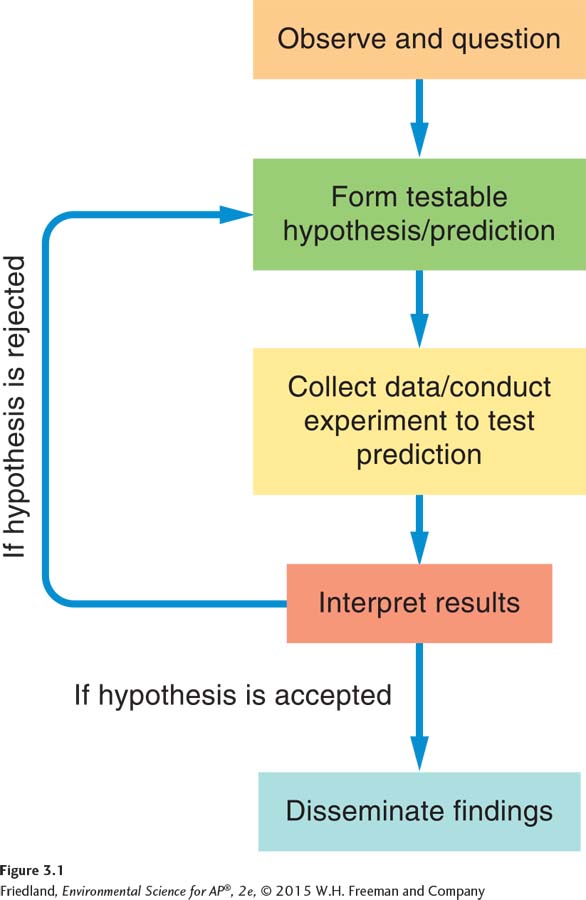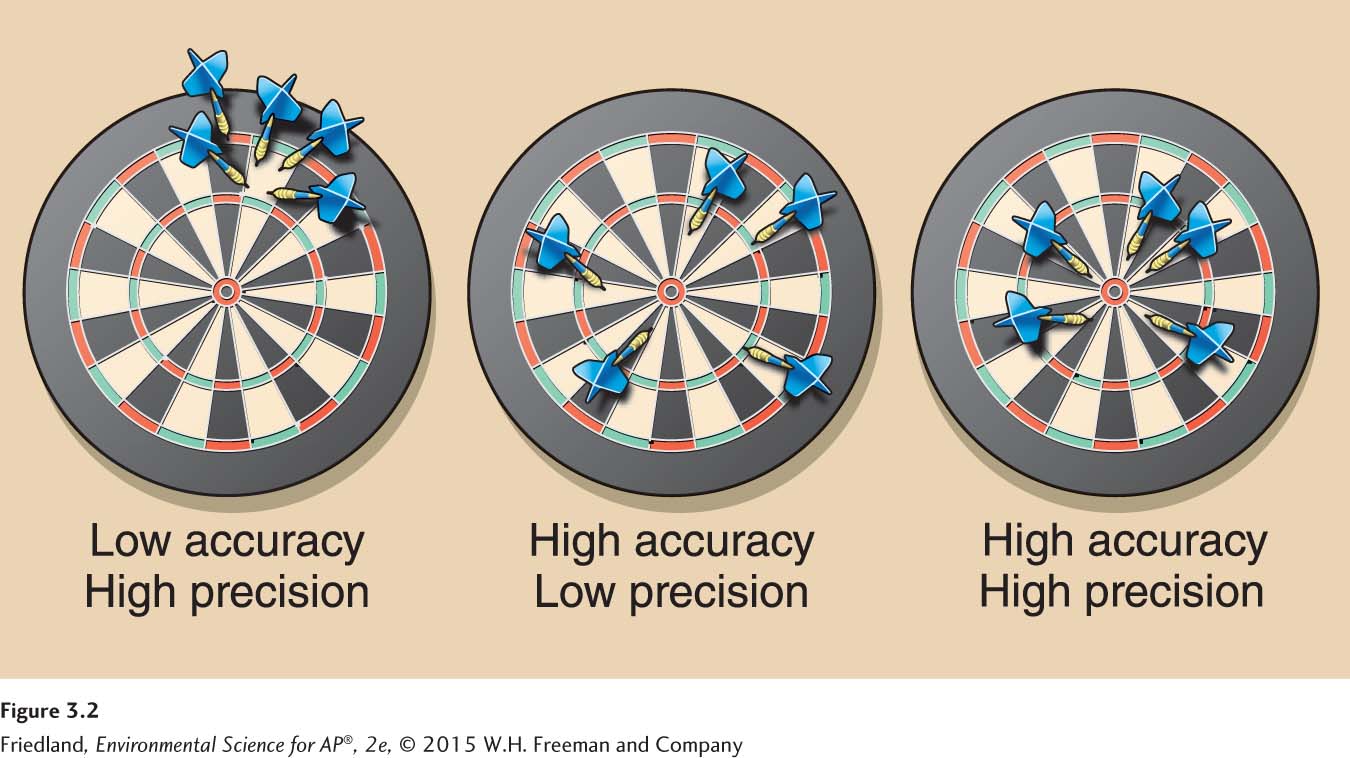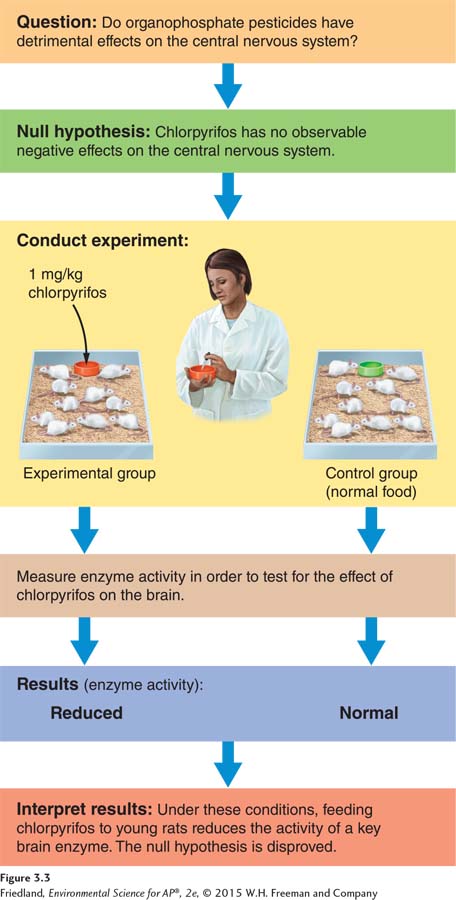module 3 Scientific Method
Environmental indicators are important for understanding human impacts on Earth systems and the sustainability of those systems. In order to evaluate environmental indicators, we need to use reproducible scientific methods. An understanding of the scientific method is essential for environmental science.
Learning Objectives
After reading this module you should be able to
explain the scientific method and its application to the study of environmental problems.
describe some of the unique challenges and limitations of environmental science.
Science is a process
Humans during the past century have learned a lot about the impact of their activities on the natural world. Scientific inquiry has provided great insights into the challenges we are facing and has suggested ways to address those challenges. For example, a hundred years ago, we did not know how significantly or rapidly we could alter the chemistry of the atmosphere by burning fossil fuels. Nor did we understand the effects of many common materials, such as lead and mercury, on human health. Much of our knowledge comes from the work of researchers who study a particular problem or situation to understand why it occurs and to determine how we can fix or prevent it from occurring. In this section we will look at the process scientists use to ask and answer questions about the environment.
The Scientific Method
Scientific method An objective method to explore the natural world, draw inferences from it, and predict the outcome of certain events, processes, or changes.

To investigate the natural world, scientists, such as those who examined the effects of fracking as described at the beginning of this chapter, have to be as objective and methodical as possible. They must conduct their research in such a way that other researchers can understand how their data were collected and agree on the validity of their findings. To do this, scientists follow a process known as the scientific method, which is an objective way to explore the natural world, draw inferences from it, and predict the outcome of certain events, processes, or changes. The scientific method is used in some form by scientists in all parts of the world and is a generally accepted way to conduct science.
As we can see in FIGURE 3.1, the scientific method has a number of steps, including observing and questioning, forming hypotheses, collecting data, interpreting results, and disseminating findings.
Observing and Questioning
Homeowners and scientists noticed, in areas where fracking occurred, that certain household wells contained high methane concentrations and they wanted to know why this was occurring. Such observing and questioning is where the process of scientific research begins.
Forming Hypotheses
Hypothesis A testable conjecture about how something works.
Observing and generating questions lead a scientist to formulate a hypothesis. A hypothesis is a testable conjecture about how something works. It may be an idea, a proposition, a possible mechanism of interaction, or a statement about an effect. For example, we might hypothesize that when the air temperature rises over time, certain plant species will be more likely, and others less likely, to persist.
What makes a hypothesis testable? We can test the idea about the relationship between air temperature and plant species by growing plants in a greenhouse at different temperatures. “Fish kills are caused by something in the water” is a testable hypothesis because it speculates that there is an interaction between something in the water and the observed dead fish.
Null hypothesis A prediction that there is no difference between groups or conditions, or a statement or an idea that can be falsified, or proved wrong.
Sometimes it is easier to prove something wrong than to prove it is true beyond doubt. In this case, scientists use a null hypothesis. A null hypothesis is a prediction that there is no difference between groups or conditions, or a statement or idea that can be falsified, or proved wrong. The statement “Fish deaths have no relationship to something in the water” is an example of a null hypothesis.

Collecting Data
Replication The data collection procedure of taking repeated measurements.
Sample size The number of times a measurement is replicated in data collection.
Scientists typically take several sets of measurements—
Accuracy How close a measured value is to the actual or true value.
Precision How close the repeated measurements of a sample are to one another.
Uncertainty An estimate of how much a measured or calculated value differs from a true value.
Proper procedures yield results that are accurate and precise. They also help us determine the possible relationship between our measurements or calculations and the true value. Accuracy refers to how close a measured value is to the actual or true value. For example, an environmental scientist might estimate how many songbirds of a particular species there are in an area of 1,000 ha by randomly sampling 10 ha and then projecting or extrapolating the result up to 1,000 ha. If the extrapolation is close to the true value, it is an accurate extrapolation. Precision is how close to one another the repeated measurements of the same sample are. In the same example, if the scientist counted birds five times on five different days and obtained five results that were similar to one another, the estimates would be precise. Uncertainty is an estimate of how much a measured or calculated value differs from a true value. In some cases, it represents the likelihood that additional repeated measurements will fall within a certain range. Looking at FIGURE 3.2, we see that high accuracy and high precision is the most desirable result.
Interpreting Results
We have followed the steps in the scientific method from making observations and asking questions, to forming a hypothesis, to collecting data. What happens next? Once results have been obtained, analysis of data begins. A scientist may use a variety of techniques to assist with data analysis, including summaries, graphs, charts, and diagrams.
As data analysis proceeds, scientists begin to interpret their results. This process normally involves two types of reasoning: inductive and deductive. Inductive reasoning is the process of making general statements from specific facts or examples. If the scientist who sampled a songbird species in the preceding example made a statement about all birds of that species, she would be using inductive reasoning. It might be reasonable to make such a statement if the songbirds that she sampled were representative of the whole population. Deductive reasoning is the process of applying a general statement to specific facts or situations. For example, if we know that, in general, air pollution kills trees, and we see a single, dead tree, we may attribute that death to air pollution. But a conclusion based on a single tree might be incorrect, since the tree could have been killed by something else, such as a parasite or fungus. Without additional observations or measurements, and possibly experimentation, the observer would have no way of knowing the cause of death with any degree of certainty.
The most careful scientists always maintain multiple working hypotheses—
Disseminating Findings
A hypothesis is never confirmed by a single experiment. That is why scientists not only repeat their experiments themselves, but also present papers at conferences and publish the results of their investigations. This dissemination of scientific findings allows other scientists to repeat the original experiment and verify or challenge the results. The process of science involves ongoing discussion among scientists, who frequently disagree about hypotheses, experimental conditions, results, and the interpretation of results. Two investigators may even obtain different results from similar measurements and experiments, as happened with investigations of fracking. Only when the same results are obtained over and over by different investigators can we begin to trust that those results are valid. In the meantime, the disagreements and discussion about contradictory findings are a valuable part of the scientific process. They help scientists refine their research to arrive at more consistent, reliable conclusions.
Like any scientist, you should always read reports of “exciting new findings” with a critical eye. Question the source of the information, consider the methods or processes that were used to obtain the information, and draw your own conclusions. This process, essential to all scientific endeavors, is known as critical thinking.
Theory A hypothesis that has been repeatedly tested and confirmed by multiple groups of researchers and has reached wide acceptance.
A hypothesis that has been repeatedly tested and confirmed by multiple groups of researchers and has reached wide acceptance becomes a theory. Current theories about how plant species distributions change with air temperature, for example, are derived from decades of research and evidence. Notice that this sense of theory is different from the way we might use the term in everyday conversation (such as, “But that’s just a theory!”). To be considered a theory, a hypothesis must be consistent with a large body of experimental results. A theory cannot be contradicted by any replicable tests.
Scientists work under the assumption that the world operates according to fixed, knowable laws. We accept this assumption because it has been successful in explaining a vast array of natural phenomena and continues to lead to new discoveries. When the scientific process has generated a theory that has been tested multiple times, we can call that theory a natural law. A natural law is a theory to which there are no known exceptions and which has withstood rigorous testing. Familiar examples include the law of gravity and the laws of thermodynamics, which we will look at in the next chapter. These theories are accepted as facts by the scientific community, but they remain subject to revision if contradictory data are found.
Scientific Method in Action: The Chlorpyrifos Investigation
Let’s look at what we have learned about the scientific method in the context of an actual scientific investigation. In the 1990s, scientists suspected that organophosphates—

The Hypothesis
The researchers investigating the effects of chlorpyrifos on human health formulated a hypothesis: Chlorpyrifos causes neurological disorders and negatively affects human health. Because this hypothesis would be hard to prove conclusively, the researchers also proposed a null hypothesis: Chlorpyrifos has no observable negative effects on the central nervous system. We can follow the process of their investigation in FIGURE 3.3.
Testing the Hypothesis
Control group In a scientific investigation, a group that experiences exactly the same conditions as the experimental group, except for the single variable under study.
To test the null hypothesis, the scientists designed experiments using rats. One experiment used two groups of rats, with 10 individuals per group. The first group—
The Results
At the end of the experiment, the researchers found that the rats exposed to chlorpyrifos had much lower levels of the enzyme choline acetyltransferase in their brains than the rats in the control group. But without a control group for comparison, the researchers would never have known whether the chlorpyrifos or something else caused the change observed in the experimental group.
The discovery of the relationship between ingesting chlorpyrifos and a single change in brain chemistry might seem relatively small. But that is how most scientific research works: Very small steps establish that an effect occurs and, eventually, how it occurs. In this way, we progress toward a more thorough understanding of how the world works. This particular research on chlorpyrifos, combined with numerous other experiments testing specific aspects of the chemical’s effect on rat brains, demonstrated that chlorpyrifos was capable of damaging developing rat brains at fairly low doses. The results of this research have been important for our understanding of human health and toxic substances in the environment.

Controlled Experiments and Natural Experiments
The chlorpyrifos experiment we have just described was conducted in the controlled conditions of a laboratory. However, not all experiments can be done under such controlled conditions. For example, it would be difficult to study the interactions of wolves and caribou in a controlled setting because both species need large amounts of land and because their behavior changes in captivity. Other reasons that a controlled laboratory experiment may not be possible include prohibitive costs and ethical concerns.
Natural experiment A natural event that acts as an experimental treatment in an ecosystem.
Under these circumstances, investigators look for a natural experiment. A natural experiment occurs when a natural event acts as an experimental treatment in an ecosystem. For example, a volcano that destroys thousands of hectares of forest provides a natural experiment for understanding large-
Because a natural experiment is not controlled, many variables can change at once, and results can be difficult to interpret. Ideally, researchers compare multiple examples of similar systems in order to exclude the influences of different variables. For example, after a forest fire, researchers might not only observe how a burned forest responds to the disturbance but also compare it with a nearby forest that did not burn. In this case, the researchers are comparing similar forests that differ in only one variable, fire. If, however, they tried to compare the burned forest with a different type of forest, perhaps one at a different elevation, it would be difficult to separate the effects of the fire from the effects of elevation. Still, because they may be the only way to obtain vital information, natural experiments are indispensable.
Let us return to the study of chlorpyrifos. Researchers wanted to know if human brains that were exposed to the chemical would react in the same way as rat brains. Because researchers would never feed pesticides to humans to study their effects, for obvious ethical reasons, they conducted a natural experiment. They looked for groups of people who were similar in most ways—
Science and Progress
The chlorpyrifos experiment is a good example of the process of science. Based on observations, the scientists proposed a hypothesis and null hypothesis. The null hypothesis was tested and rejected. Multiple rounds of additional testing gave researchers confidence in their understanding of the problem. Moreover, as the research progressed, the scientists informed the public, as well as the scientific community, about their results. Finally, in 2000, as a result of the step-
Environmental science presents unique challenges
Environmental science has many things in common with other scientific disciplines. However, it presents a number of challenges and limitations that are not usually found in most other scientific fields. These challenges and limitations are a result of the nature of environmental science and the way research in the field is conducted.

Lack of Baseline Data
The greatest challenge to environmental science is the fact that there is no undisturbed baseline—
Subjectivity
A second challenge unique to environmental science lies in the dilemmas raised by subjectivity. For example, when you go to the grocery store, the bagger may ask, “Paper or plastic?” How can we know for certain which type of bag has the least environmental impact? There are techniques for determining what harm may come from using the petrochemical benzene to make a plastic bag and from using chlorine to make a paper bag. However, different substances tend to affect the environment differently: Benzene may pose more of a risk to people, whereas chlorine may pose a greater risk to organisms in a stream. It is difficult, if not impossible, to decide which is better or worse for the environment overall. There is no single measure of environmental quality. Ultimately, our assessments and our choices involve value judgments and personal opinions.
Interactions
A third challenge is the complexity of natural and human-
There are also many examples in which human preferences and behaviors affect environmental systems as much as the natural laws that describe them. For example, many people assume that if we built more efficient automobiles, the overall consumption of gasoline in the United States would decrease. To decrease gas consumption, however, it is necessary not only to build more efficient automobiles, but also to get people to purchase those vehicles and use them in place of less efficient ones. During the 1990s and early 2000s, even though there were many fuel-

Human Well-
As we continue our study of environmental science, we will see that many of its topics touch on human well-
We know that people who are unable to meet their basic needs are less likely to be interested in or able to be concerned about the state of the natural environment. The principle of environmental equity—